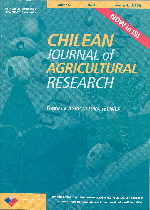
|
Agricultura Técnica
Instituto de Investigaciones Agropecuarias, INIA
ISSN: 0365-2807
EISSN: 0365-2807
Vol. 61, No. 1, 2001, pp. 42-50
|
 Bioline Code: at01005
Bioline Code: at01005
Full paper language: Spanish
Document type: Research Article
Document available free of charge
|
|
|
Agricultura Técnica, Vol. 61, No. 1, 2001, pp. 42-50
| en |
Detection of a Bovine Genetic Defect by a DNA Probe
Felmer, Ricardo D.; Butendieck, Norberto B.; Butendieck, Bárbara B. & Villegas, Juana M.
Abstract
The adhesion deficiency of bovine leukocytes to antigens,
known as BLAD (bovine leukocyte adhesion deficiency), is a hereditary
genetic disease which is lethal for the Holstein breed. It is a recessive
autosomal disease that can be transmitted to the offspring. The objective
of this research was to standardize the molecular techniques to diagnose
BLAD and also to get a first approximation of the genetic frequency of
the mutated allele in the bull population of the IX
th
and X
th
Regions. DNA amplification using polymerase chain reaction (PCR) and posterior
digestion with restriction enzymes
Taq
I and
Hae
III was performed. The digested product was analyzed by 4% agarose gel
electrophoresis and ethidium bromide staining to show the typical restriction
fragments present in normal, carrier and infected cattle. The technique
was validated with a screening test of 59 cattle. Out of 55 bulls analyzed,
one turned out to be a BLAD carrier, which suggests a genetic frequency
of 1.79% in the bull population of the IX
th
and X
th
Regions. The diagnostic technique of PCR and the digestion of the amplification
product with two restriction enzymes (
Taq
I and
Hae
III) has identified with accuracy the genotype of cattle at a specific
locus
and allows an early identification of the genetic defect known as BLAD
in infected and carrier animals.
Keywords
bovine leukocyte adhesion deficiency, BLAD, PCR, Holstein breed, RFLP, disease
|
| |
| pt |
Detección de un Defecto Genético en Bovinos Mediante una Prueba de ADN
Felmer, Ricardo D.; Butendieck, Norberto B.; Butendieck, Bárbara B. & Villegas, Juana M.
|
| |
| es |
Felmer, Ricardo D.; Butendieck, Norberto B.; Butendieck, Bárbara B. & Villegas, Juana M.
Resumen
La deficiencia en la capacidad de unión de leucocitos
bovinos a los antígenos, más conocida como BLAD, es una enfermedad
hereditaria que resulta letal para el ganado de la raza Holstein. Su principal
característica es ser una enfermedad autosómica recesiva que
puede ser transmitida a la descendencia. El objetivo del trabajo fue estandarizar
la metodología para realizar un diagnóstico de la enfermedad
mediante técnicas moleculares y lograr una primera aproximación
sobre la frecuencia génica del alelo mutado en algunas poblaciones
de toros de la IX y X Región. En base a la amplificación del
ADN mediante reacción en cadena de polimerasa (PCR) y posterior digestión
con enzimas de restricción
Taq
I y
Hae
III, fue posible visualizar, mediante electroforesis en gel de agarosa
al 4%, los fragmentos de restricción característicos para bovinos
normales, portadores o enfermos. La técnica se validó mediante
un muestreo de 59 bovinos. De los 55 toros analizados uno resultó
ser portador de BLAD, lo que implica una frecuencia génica de 1,79%
en la población de toros de la IX y X Región. La técnica
de PCR acoplada a la digestión con enzimas de restricción (
Hae
III y
Taq
I) ha demostrado que identifica inequívocamente el genotipo del ganado
en un
locus
determinado y permite el diagnóstico certero y precoz de aquellos
animales enfermos y/o portadores del defecto hereditario conocido como
BLAD.
Palabras-clave
deficiencia de adhesión leucocitaria bovina, BLAD, PCR, RFLP, Holstein, enfermedad
|
| |
© Copyright 2001 - Instituto de Investigaciones Agropecuarias, INIA (Chile)
Alternative site location: http://www.inia.cl/at/agritec.htm
|
|
